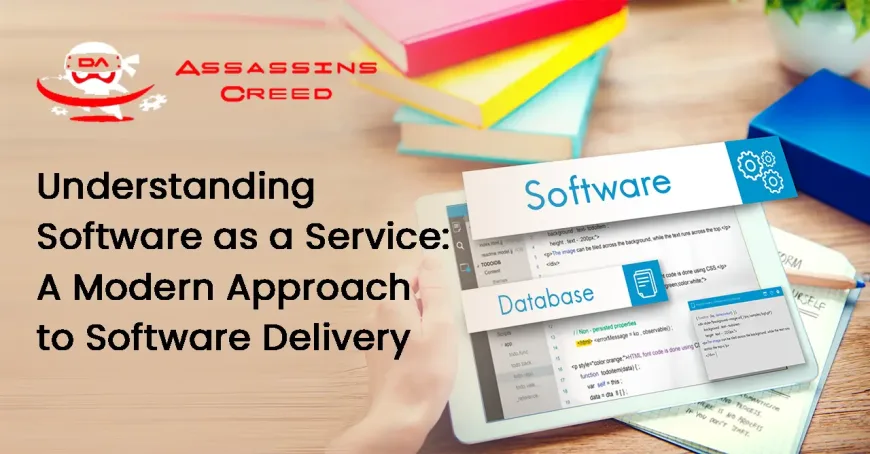- 3rd October, 2025
- By Rob Lawson
Understanding Software as a Service: A Modern Approach to Software Delivery

If you’ve ever wondered how companies, from startups to global enterprises, manage to harness cutting-edge software without draining their budgets upfront, the answer lies in Software as a Service (SaaS). Think back to when businesses had to buy bulky software packages, install them from discs, and pay for costly upgrades every couple of years. Those days are long gone. Today, software is delivered seamlessly over the Internet, allowing organisations to pay only for what they need, when they need it, scaling with their growth rather than restricting it.
But SaaS isn’t just about saving money. It’s about unlocking flexibility, agility, and efficiency in a fast-paced digital economy where every competitive edge matters. In this article, we’ll take a closer look at what SaaS really means, the unique advantages it offers, and the challenges you should be aware of. Whether you’re a small business owner looking for smarter tools or an established enterprise aiming to optimise operations, embracing SaaS could be the game-changer that transforms how you work, compete, and grow.
What is SaaS?
SaaS, short for Software as a Service, is a modern way of delivering software through the cloud. Instead of buying a program, installing it on your computer, and worrying about updates or compatibility, SaaS lets you simply log in via the internet and start using the tools you need.
Think of it like subscribing to Netflix or Spotify, you don’t purchase the entire library, you just pay a recurring fee to access content whenever and wherever you want. In the same way, businesses pay a monthly or annual subscription for SaaS platforms that give them instant access to powerful software.
Some well-known examples include Google Workspace (Docs, Sheets, Gmail) for collaboration, Slack for team communication, Salesforce for customer relationship management, and Shopify for e-commerce. These platforms have become everyday essentials for companies because they’re accessible from anywhere, constantly updated, and don’t require costly hardware or IT teams to manage.
This subscription-based model not only reduces upfront investment but also makes it easier to forecast budgets, scale usage as your business grows, and ensure you’re always working with the latest, most secure version of the software.
From Discs to the Cloud
In the not-too-distant past, purchasing software meant buying a hard copy, often on a CD or DVD, and installing it on your computer. It was a cumbersome process, requiring physical storage space, and updates were a whole other challenge: you had to wait for new versions, download patches, or even buy an entirely new edition.
With SaaS, everything is hosted in the cloud computing model, meaning you can access the latest version of the software anytime, anywhere, as long as you have an internet connection.
Benefits of SaaS for Businesses
For businesses of all sizes, whether it’s a lean startup seeking agility or a large enterprise managing complex operations, SaaS offers a wide range of advantages that extend far beyond mere convenience. It’s not just about moving software to the cloud; it’s about transforming how companies operate, collaborate, and grow in a digital-first world. From reducing upfront costs and simplifying IT management to empowering remote workforces and enabling seamless scalability, SaaS has become a vital driver of efficiency and innovation across industries.
It's no surprise that SaaS adoption continues to surge; nearly 77% of companies are using at least one SaaS solution, with over 80% integrating multiple applications into their operations. This widespread adoption underscores the increasing reliance on cloud-based solutions across industries.
The global SaaS market is projected to reach $390.5 billion in 2025, driven by factors such as cost-effectiveness, scalability, and the accelerating pace of digital transformation.
Examples of SaaS Applications
SaaS covers a wide spectrum of applications that help businesses streamline operations, improve efficiency, and enhance collaboration. Some of the most prominent categories include:
And this is just the tip of the iceberg. Vainu estimates that over 24,365 SaaS solutions were available in 2023, with customer service (17,000+), marketing (14,800+), and e-commerce tools occupying the top categories. This staggering variety highlights just how deeply SaaS has permeated every aspect of business operations today.

Website as a Service: A New Frontier
In today’s digital-first world, a business website is more than just an online brochure, it’s a critical tool for attracting customers, generating leads, and driving growth. Traditionally, building a website meant paying a one-off website cost for design and development, plus separate fees for hosting, maintenance, and updates.
Enter Website as a Service (WaaS), a growing niche within the SaaS ecosystem that offers small business solutions for companies of all sizes. Providers like CoreDNA offer subscription-based models where everything, from strategy and content updates to SEO and marketing, is bundled into a single monthly fee. This approach ensures businesses always have a modern, optimised, and high-performing site while keeping costs predictable. Unlike traditional development, WaaS focuses on continuous improvement and often includes strategic elements like SEO and marketing support. WaaS not only reduces upfront website costs but also supports a broader business strategy by keeping your online presence agile, competitive, and aligned with evolving market demands.
Challenges and Considerations
While SaaS offers a wide range of benefits, businesses should also be aware of certain challenges to ensure they get the most value from these solutions:
Future Trends in SaaS
As businesses continue to embrace digital transformation, the SaaS landscape is evolving at a rapid pace, offering new opportunities to optimise operations and gain a competitive edge. Key trends shaping the future of SaaS include:
In essence, SaaS presents businesses with an unparalleled opportunity to optimise operations, reduce costs, and stay competitive in an ever-changing digital world. Whether you’re considering a new CRM system, exploring website management solutions, or looking to implement small business solutions, the flexibility, scalability, and convenience of SaaS make it a cornerstone of modern business strategy.
Key Takeaway
SaaS is transforming how businesses operate, offering flexibility, cost savings, and streamlined processes. Website as a Service (WaaS) takes this a step further, delivering a fully managed, optimised, and secure website that adapts to your business needs, eliminating the usual complexities of design, updates, and maintenance.
If you’re ready to simplify your website management and harness the power of WaaS, the team at Digital Assassin can help. Our tailored WaaS plans include ongoing content, SEO, and security best practices, designed to keep your site performing at its best.
Start your WaaS journey today, contact an Assassin, and let’s build your modern, high-performing website.
Frequently Asked Questions
1. What is SaaS, and how does it benefit businesses?
SaaS (Software as a Service) is cloud-based software delivered over the internet via subscription. Businesses benefit from flexibility, cost savings, scalability, and automatic updates, making it easier to manage operations, collaborate, and stay competitive without large upfront investments.
2. How does SaaS differ from traditional software?
Unlike traditional software that requires purchase, installation, and manual updates, SaaS is subscription-based and cloud-hosted. This means businesses can access the latest software from any device, anytime, without worrying about maintenance or hardware costs.
3. What are some common examples of SaaS applications?
Popular SaaS solutions include Google Workspace for collaboration, Salesforce for CRM, Xero and QuickBooks for accounting, Slack for communication, and Shopify for e-commerce. In total, over 24,000 SaaS solutions are serving various business functions such as customer service, marketing, and online sales.
4. What is Website as a Service (WaaS), and who can benefit from it?
Website as a Service (WaaS) is a subscription-based model that provides fully managed, optimised, and secure websites. Small businesses, startups, and enterprises can benefit from WaaS by reducing upfront website costs, receiving continuous updates, SEO, and marketing support, and focusing on broader business strategy.
5. What are the main challenges of using SaaS?
While SaaS offers many advantages, businesses should be aware of data security risks, internet dependency, subscription fatigue, and vendor lock-in. Choosing reputable providers and conducting regular audits can mitigate these challenges.
6. How is SaaS evolving in the future?
Future trends include AI and machine learning integration, industry-specific solutions, and enhanced mobile accessibility. These innovations help businesses automate tasks, gain actionable insights, and allow teams to work efficiently from any location.
7. How widely is SaaS adopted across businesses?
SaaS adoption is growing rapidly, with nearly 77% of companies using at least one SaaS solution and over 80% integrating multiple applications. The global SaaS market is projected to reach $390.5 billion by 2025, reflecting its critical role in modern business operations.
8. How can I get started with SaaS or WaaS for my business?
Start small by implementing SaaS applications like CRM, accounting, or collaboration tools, then scale as needed. For websites, Digital Assassin offers WaaS plans that handle ongoing management, content, SEO, and security, allowing businesses to focus on growth rather than technical maintenance.